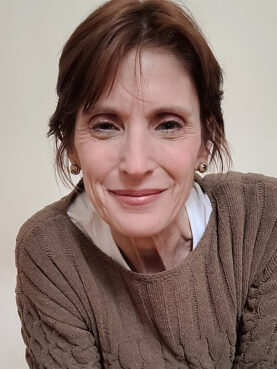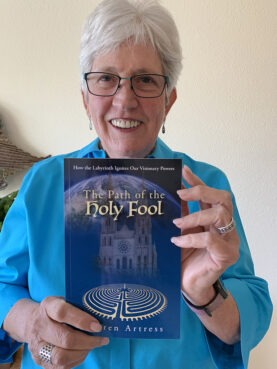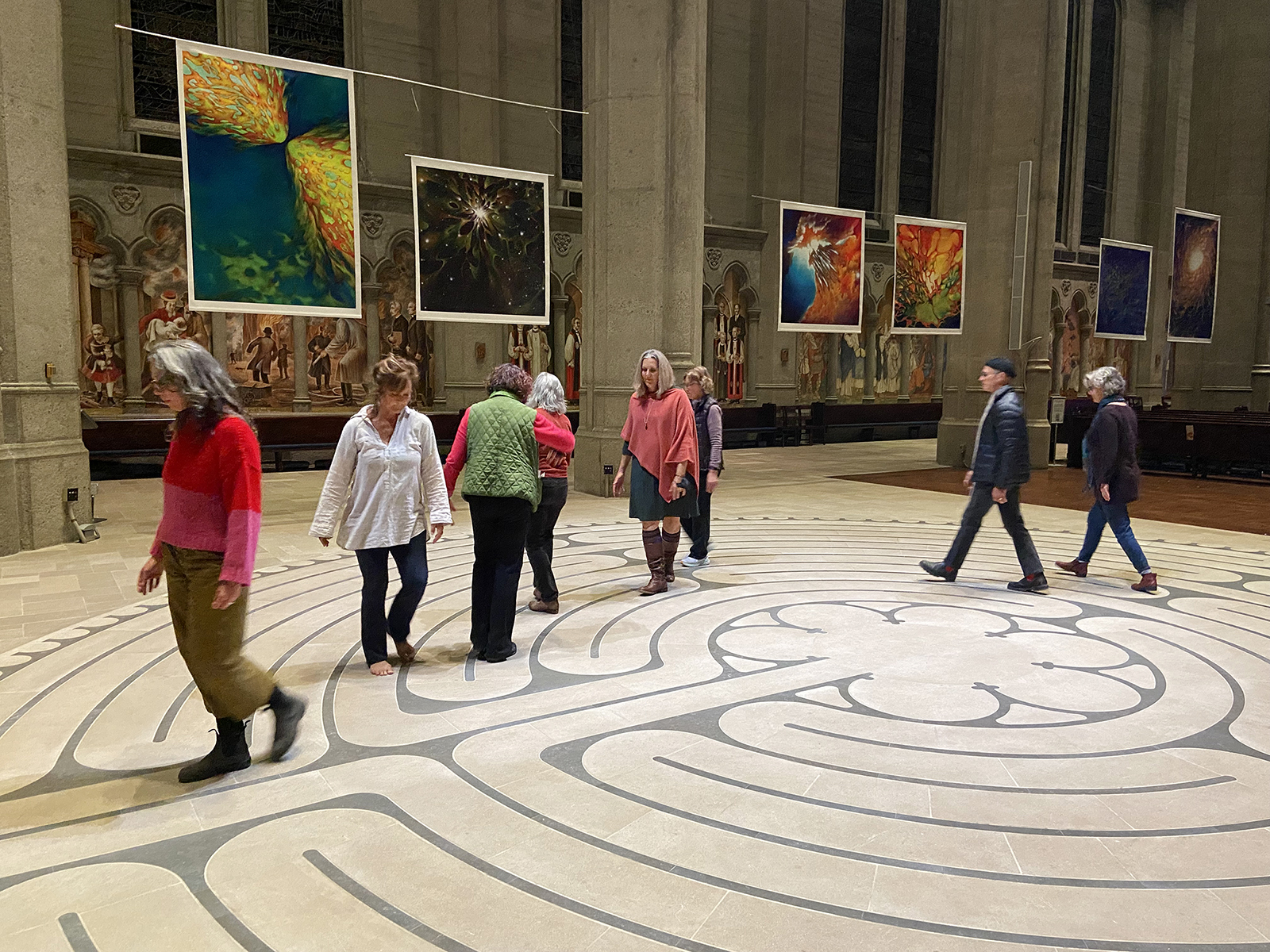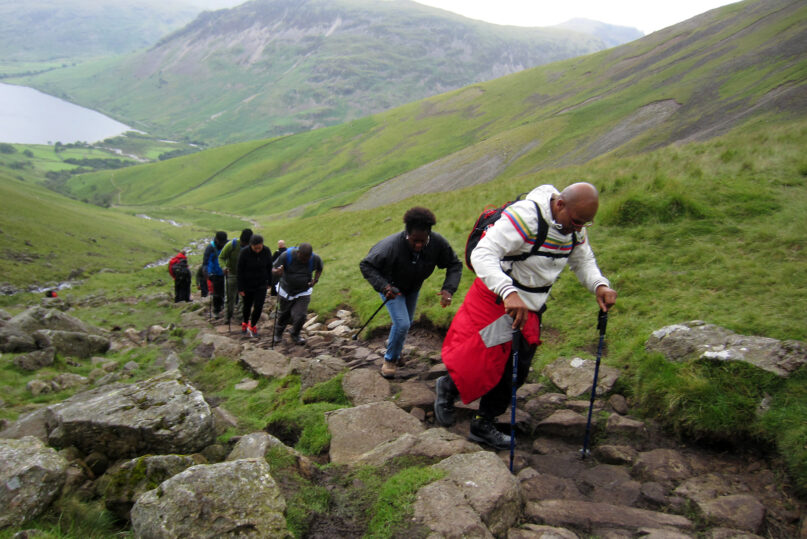(RNS) — For years, at 9:30 a.m. on the first Saturday of the month, Mark Hutchinson could usually be found at the edge of the city of Sheffield, England, about to embark into the countryside with a dozen others — mostly people of color — for a three-hour walk.
“It’s part of our very specific aim that the countryside should be open to people, whatever their race or gender, sexuality, disability, mental health awareness,” Hutchinson told Religion News Service about the group — originally called Black Men Walking, now Walk4Health — when it was formed in 2003. After decades of walks, the core members became as close as some family members.
But just as Britain’s pandemic shutdowns began, Hutchinson, 62, was diagnosed with cancer. The walks were often canceled, and he rarely felt well enough to go. After days of praying and asking God how to cope with the diagnosis, one answer came in the form of two members of his longtime walking group.
“I still wanted to do walking and I didn’t know whether I would be up for walking with the group. But I felt that I could turn to both of my close colleagues and walk with them.”
Hutchinson, raised Anglican, said his close friends aren’t religious, but for him their shorter walks have taken on a spiritual quality, becoming a buoy of support and a time of sacred companionship.

Laura Wellington. Courtesy photo
There’s nothing new about walking for one’s health, or even for spiritual succor. But in the past three pandemic years, walking outdoors became for many a COVID-19-safe way to continue meditating, praying or connecting with nature in community. And as mortality rates drove people to realign their priorities, many simply turned to walking as a venue for introspection.
When the pandemic hit Laura Wellington’s shoreline town of Madison, Connecticut, she recognized that the health crisis would bring a deeper reconfiguration. It had happened to her: At age 35, almost two decades prior, Wellington had rebuilt her life after her husband died, leaving her to raise their four young children.
“I saw how people’s worlds were changing, just like mine did, in such a dramatic form,” said Wellington. “Friendships were being broken, people were moving, people were thrust into a situation with no experience of how to handle it.”
But it wasn’t until January 2022 that Wellington took action. Running on her treadmill as part of her early morning routine, meditating, she received what she described as a vision.
“Jesus was walking, and there was a voice inside of me saying, bring people together through walking,” she recalled.
About two weeks later, the vision recurred, but this time Jesus was carrying a bag, which, she sensed, held an idea. Just then Jesus cut the bag open with scissors and the idea came out. “He said to me, ‘Don’t worry, it will work,’” said Wellington.

Examples of the Zneex app. Courtesy image
Drawing on input from her own pandemic walking group, Wellington developed the concept for Zneex (pronounced like “sneaks,” short for sneakers, but with a “Z”), an app that connects people to new walking partners. She teamed with an outside company to build the app, which launched in December and has been dowloaded more than 3,000 times across the U.S., according to Wellington.
The app allows users to connect and chat with walking buddies within a five-mile radius, schedule walks and walk reminders, record miles and steps and select walking buddies based on vaccine status. A premium version offers nationwide access, phone and video chats for virtual walks, and personalized age and gender preferences. (Zneex is currently only available for Android phones, but an iPhone version is expected in August.)
“In a way, it’s a new type of ministry. You’re bringing people together, getting them to talk and listen, getting them to come together as a community,” said Wellington, who was raised Catholic and considers herself a Christian who also sees God’s presence in all major religions.
Though she doesn’t view Zneex as an evangelistic tool, she does believe app users are opening themselves up to connection with others and with nature, which can in turn be avenues for connecting with the divine.
“I honestly think, with the way this was created, and the spirit in which it came, I think every person who signs up will have the hand of God on them as they’re walking,” she said.

The Rev. Lauren Artress with her book “The Path of the Holy Fool.” Courtesy photo
The Rev. Lauren Artress, an Episcopal priest and founder of the labyrinth-promoting nonprofit Veriditas, said that the ancient practice of labyrinth walking, which has made a comeback in recent decades, also got a boost during the pandemic.
“It’s put people into a reflective place about who they are, what they’re doing with their lives and why they’re on this planet,” said Artress. “They’ve discovered that labyrinths are a place for that kind of reflection, to be present with yourself.”
Artress said labyrinth walking surges in popularity during a time of crisis. She moved to San Francisco to become canon pastor at Grace Cathedral in the late 1980s, during the peak of the AIDS epidemic, and supported her congregants after the 1989 Loma Prieta earthquake.
“We buried 92 people,” she said of the earthquake aftermath. “And so I was ready to leave the cathedral. I was burned out.”
Instead of leaving, Artress discovered labyrinths, and when she introduced the practice to Grace Cathedral in 1991, it helped ignite a labyrinth movement in the United States, a precursor to the more recent, pandemic-induced resurgence.
Not to be confused with a maze, which misleads with false routes and dead ends, a labyrinth has one long, circuitous path that winds its way to the center and back out again.
“The labyrinth really can help people regroup, it can give people sustenance, it’s a great path of prayer,” said Artress, who explained that labyrinths aren’t affiliated with a particular faith. “It’s a walking meditation, it’s a crucible change, it’s a tool of manifestation.”

Participants of a Women’s Dream Quest walk a labyrinth at Grace Cathedral, Nov. 18, 2022, in San Francisco. Photo by Lars Howlett
Artress said her organization trained a record number of people, almost 200, as labyrinth facilitators during the height of the pandemic. The online format allowed for a wide reach: She trained pastors, mental health professionals and laypeople from places including Qatar, Serbia, Budapest and Poland. According to Bloomberg, some labyrinth builders saw increased demand for residential labyrinths during COVID-19.
“They occur when culture is going through dramatic change,” Artress said. “They emerge when we need them, when the culture is destabilized.”
Hutchinson, in Sheffield, hasn’t yet been able to return to the three- or four-hour Saturday walks he used to take, but while he continues shorter walks with smaller groups, he has also found spiritual renewal in walking solo.
“Especially when you had to walk on your own, it gives you a time to talk to God,” he said. “You realize how much we are one of God’s creatures on this planet, and can revel in the magnificence of what God has put on this planet for us. … The foliage on the leaves when it rains, hearing rainwater splashing on the ground. And then your busy lives stop and you just look again, through the prism of what God has provided.”





